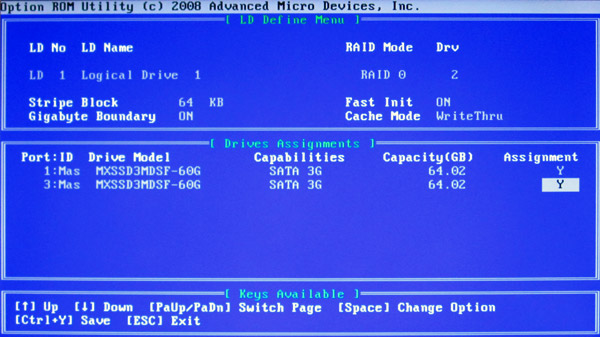
| Manufacturer | Mach Xtreme Technology |
| Article number | MXSSD3MDSF-60G |
| Capacity | 60GB |
| Interface | SATA3 6GB/s |
| Cache | – |
| Controller | Sandforce 2281 |
| Flash Type | Intel MLC – Multi-Level-Cell |
| Size | 2.5″ (99.8 x 69.63 x 9.3mm) |
| Weight | 80 gramm |
| Speed | Read up to 530 MB/s / Write up to 490 MB/s |
| Seek Time | <0.1 |
| Power Consumption | 1.6 Watt idle / 2.8 Watt in operation |
| MTBF | 2 million hours |
| Other | TRIM Support, GC Support, Hot Plug Support |
SSD firmware update …
We update the firmware of the SSDs before we begin with the tests.
That is especially meaningful with the SSD with Sandforce 2281 controller, since there are clear performance improvements with newer firmware versions.
The SSD was delivered with the firmware version 3.30.
To the point of testing time, Mach Xtreme Technology offered the version 3.32, which we updated with the MX DS Field Updater.
RAID Setup …
The RAID installation is essentially quite simple:
– first attach both SSD drives at a RAID capable controller e.g. on the motherboard.
– then enable the RAID controller in the BIOS or by a Jumper (pay attention to additional references in the manual) and change the SATA controller in the BIOS from IDE or AHCI to RAID.
– at the next start enter now the RAID BIOS with the explained key combination (ASRock e.g. CTRL+F).
– there activate the desired RAID assignment.
In order to explain only two simple RAID array type possibilities (there are still some further combinations):
RAID1 mirror drives, in order to operate two or more drives at the expense of the size as much fail safe as possible reduntant.
RAID0 stripe drives, in order to operate two or more drives at the expense of the data loss possibility with higher performance, thus without redundancy.
Since we would like to reach a higher SSD speed, we setup a RAID-0 Striping.
First with a Stripe block size of 64KB and then again in comparison to it with a Stripe block size of 128KB.
Gigabyte Boundary remains on ON, Fast Init remains on ON and Cache Mode on WriteThru.
Here is a screenshot of the RAID BIOS ROM, where both 64 GB SSD drives are combined with RAID0 into one 128 GB SSD logical drive, in order to achieve a higher performance:

After creating the RAID array we restart the PC and see now the new logical drive assembly, to which we assigned the LD name ocinside, which we can partition and format now in the Windows like a conventional drive.


